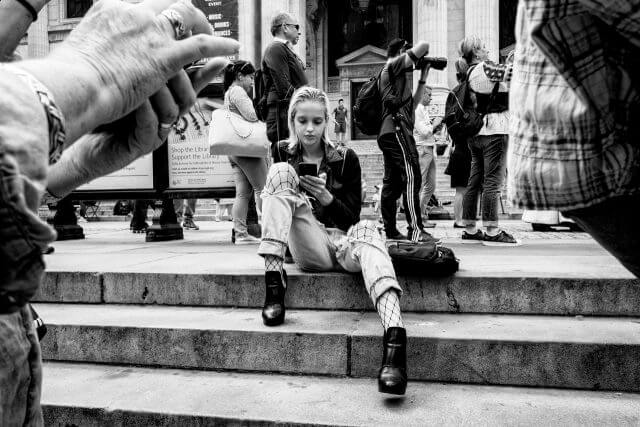If you’ve ever heard people talk about photos that tell a story, you may have wondered to yourself exactly how one tells a story with a single photo. It’s a logical thing to ponder; of course you can’t embody exposition, complication and resolution in one image, but a single image can definitely convey character, setting and plot, thus telling a story.
The following tips will be helpful particularly to budding street photographers but shooters of all stripes will hopefully find something of value here as you endeavor to successfully tell a story via photographic imagery.
Compose Wisely
When you’re shooting in a rapidly changing, unpredictable environment you shouldn’t expect to always come away with photos that perfectly conform to the traditional rules. In fact, if there’s one genre in which unorthodox composition is more likely to be appreciated it’s street photography. This doesn’t mean you can throw composition to the wind altogether; rather, you should concern yourself more with how effectively you’re using the space within the frame. The best stories are successful, in large part, because they are streamlined — they don’t contain any unnecessary or distracting elements. A photo that intends to tell a story should, likewise, be free of distractions. Make sure your subject is placed prominently in the scene and don’t include more supporting elements than are absolutely necessary. Less, in this case, is definitely more.

Choose Strong Subject Matter
Ideas about what constitutes a strong subject can vary greatly from one person to the next. My advice is quite simple: shoot what you like. When you’re genuinely interested in a subject, you won’t find it too difficult to treat the subject in a dignified manner and your passion will resonate with the viewer. Perhaps it’s easiest to make people the focal point of your storytelling; if you have a deep interest in the human condition, you won’t have much trouble conveying the story of each individual you photograph. Animals, however, may be you preferred subject matter — the point is, it doesn’t matter. Shoot what you love and your love will be revealed in your work.

Be Evocative
Part of telling a good story is eliciting an emotional response in the viewer. Joyous occasions are, of course, a part of most people’s lives and mundane moments are a part of many more; happy and ordinary moments can indeed make for intriguing expository photos when handled properly. Conflict and tension, however, tend to produce more earnest reactions in people. This doesn’t mean your photos have to revolve around themes of violence or anything extreme, it just means you need to put the drama front and center. Simple gestures — a pointing finger, arms extended to embrace, virtually any manner of body language, in fact — communicate drama beautifully and it prompts the viewer to use their imagination to expand upon the story.

Final Thoughts
There is no doubt that good storytelling in photography is challenging, but if this is your goal the thoughts presented above will hopefully provide something of an outline to follow as you embark on your journey to tell incorporate interesting stories into your photography. The biggest mistake one can make in this process is to become overly ambitious. Sure, creativity is at the center of everything here, but I think it bears reiterating the mantra to keep it simple. Think of a book you read or a movie you watched and felt like there was far too much going on. That’s exactly what you don’t want. Avoid visually bloated images and you’ll be golden!





1 Comment
Good article. Like your own Photzy ebooks. I also very much like David DuChemins e-books and articles from his blog on this subject. I think they are worth reading too. So are many video’s on and from Ted Forbes YouTube channel The Art of Photography worth viewing.